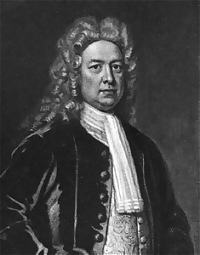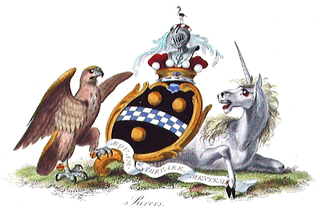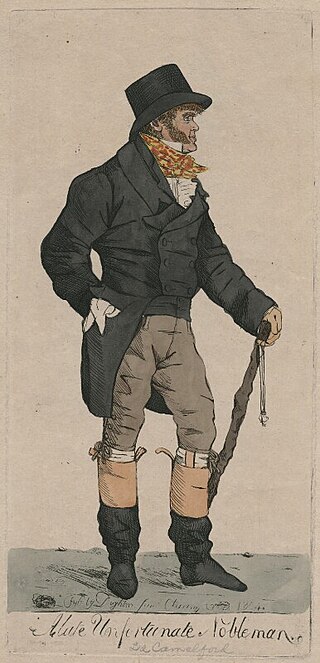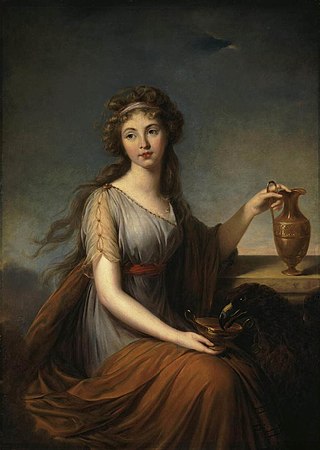
William Wyndham Grenville, 1st Baron Grenville, was a British Pittite Tory politician who served as Prime Minister of the United Kingdom from 1806 to 1807, but was a supporter of the Whigs for the duration of the Napoleonic Wars. As prime minister, his most significant achievement was the abolition of the slave trade in 1807. However, his government failed to either make peace with France or to accomplish Catholic emancipation and it was dismissed in the same year.
Hester Grenville, 1st Countess Temple, 2nd Viscountess Cobham was an English noblewoman. She was the mother and grandmother of the Prime Ministers George Grenville and William Grenville.

Baron Lyttelton is a title that has been created once in Peerage of England and twice in Peerage of Great Britain, both times for members of the Lyttelton family. Since 1889 the title has been a subsidiary title of the viscountcy of Cobham.

Viscount Cobham is a title in the Peerage of Great Britain that was created in 1718. Owing to its special remainder, the title has passed through several families. Since 1889, it has been held by members of the Lyttelton family.

Lord Kinloss is a title in the Peerage of Scotland. It was created in 1602 for Edward Bruce, later Master of the Rolls, with remainder to his heirs and assigns whatsoever. In 1604 he was also made Lord Bruce of Kinloss, with remainder to his heirs male, and in 1608 Lord Bruce of Kinloss, with remainder to any of his heirs. He was succeeded by his son, the second Lord, who was killed in a duel in 1613.

Earl Temple of Stowe, in the County of Buckingham, is a title in the Peerage of the United Kingdom. It was created in 1822 for Richard Temple-Nugent-Brydges-Chandos-Grenville, 2nd Marquess of Buckingham, who was created Marquess of Chandos and Duke of Buckingham and Chandos at the same time. In contrast to the Marquessate and Dukedom, which were created with remainder to the heirs male of his body only, the Earldom was created with remainder to (1) the heirs male of his body, failing which to (2) the heirs male of his deceased great-grandmother the 1st Countess Temple, failing which to (3) his granddaughter Lady Anna Grenville and the heirs male of her body, and then to possible younger daughters of Lord Temple and the heirs male of their bodies.

Earl of Effingham, in the County of Surrey, is a title in the Peerage of the United Kingdom, created in 1837 for Kenneth Howard, 11th Baron Howard of Effingham, named after the village of Effingham, Surrey, where heads of the family owned the manor.

Thomas Pitt of Blandford St Mary in Dorset, later of Stratford in Wiltshire and of Boconnoc in Cornwall, known during life commonly as Governor Pitt, as Captain Pitt, or posthumously, as "Diamond" Pitt was an English merchant involved in trade with India who served as President of Madras and six times as a Member of Parliament. He was the grandfather of William Pitt, 1st Earl of Chatham and was great-grandfather of Pitt the Younger, both prime ministers of Great Britain.

Earl of Londonderry is a title that has been created three times in the Peerage of Ireland. The first creation came in 1622 in favour of Thomas Ridgeway, 1st Baron Ridgeway, who served as Treasurer of Ireland and was involved in the colonisation of Ulster. He had already been created a Baronet, of Torrington in the County of Devon, in 1611, Lord Ridgeway, Baron of Gallen-Ridgeway, in the Peerage of Ireland, in 1616, and was made Viscount Gallen-Ridgeway at the same time as he was granted the earldom, also in the Peerage of Ireland. The titles became extinct on the death of his great-grandson, the fourth Earl, in 1714.
The Baronetcy of Temple, of Stowe, in the Baronetage of England, was created on the 24th of September 1611 for Thomas Temple, eldest son of John Temple of Stowe, Buckinghamshire. His great-grandson Sir Richard, 4th Baronet, was created Baron Cobham on 19 October 1714, and Viscount Cobham and Baron Cobham on 23 May 1718, the latter with a special remainder, failing his male issue to his sisters and their heirs male. Upon his death on the 13th September 1749, the barony of 1714 became extinct. Both the viscountcy and barony of 1718 passed to his elder sister, and the baronetcy passed to his second cousin once removed William Temple, of Nash House, who became 5th Baronet. On the death of Sir William's nephew Sir Richard Temple, 7th Baronet, on 15 November 1786, the baronetcy became dormant.

Earl of Chatham, of Chatham in the County of Kent, was a title in the Peerage of Great Britain. It was created in 1766 for William Pitt the Elder on his appointment as Lord Privy Seal, along with the subsidiary title Viscount Pitt, of Burton Pynsent in the County of Somerset, also in the Peerage of Great Britain.

Thomas Innes Pitt, 1st Earl of Londonderry was a British Army officer, speculator and Whig politician who sat in the House of Commons from 1713 to 1728. He served as Governor of the Leeward Islands from 1728 to his death in 1729.
Boconnoc is a civil parish in Cornwall, England, United Kingdom, approximately four miles (6 km) east of the town of Lostwithiel. According to the 2011 census the parish had a population of 96.

Baron Rivers was a title that was created four times in British history, twice in the Peerage of England, once in the Peerage of Great Britain and once in the Peerage of the United Kingdom.

Thomas Pitt, 1st Baron Camelford was a British politician who sat in the House of Commons from 1761 until 1784 when he was raised to the peerage as Baron Camelford. He was an art connoisseur.

Thomas Pitt, 2nd Baron Camelford was a British Royal Navy officer and peer best known for his participation in the Vancouver Expedition and the resulting feud with its leader, George Vancouver, during and after the expedition.
Thomas Pitt (1653–1726) was an English merchant.

Ridgeway Pitt, 3rd Earl of Londonderry of Soldon in the parish of Holsworthy in North Devon, was a British politician and peer.

Anne Grenville, Baroness Grenville was an English noblewoman and author, and a member of the Pitt family, which at the time dominated British politics.















